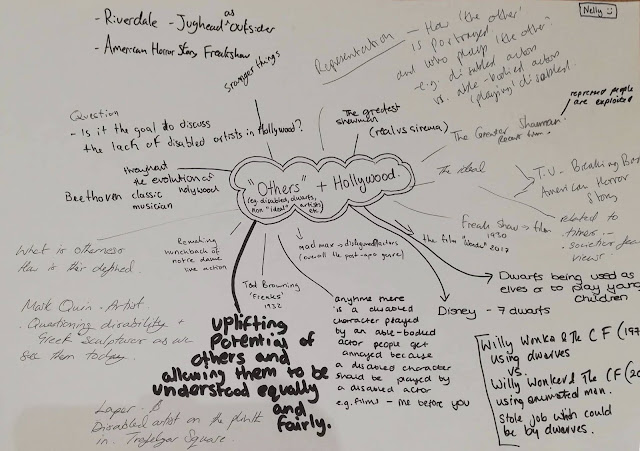Perspectives- piñata session
Today we had a task to attempt to refine and expand our ideas for thesis proposal. We wrote down our two part concept, and then passed the paper around to get a kind of crowdsourced research. I found this very useful as it gave me ideas and examples I hadn’t thought of or expected.
Below are the ideas I was given, along with some notes of my own and comments on the ideas.
Below are the ideas I was given, along with some notes of my own and comments on the ideas.
“Others” & Hollywood
“Others” being defined as disabled, dwarfs, “non-ideal” artists etc.
Questions
- Is it the goal to discuss the lack of disabled artists in Hollywood? - Yes as part of a wider discussion.
- What is otherness and how is it defined? - I intend to base my idea of Otherness upon characteristics commonly rejected or segregated from society, throughout time, whether through accessibility or social behaviours. This will not however cover race or sexuality, more on disabled and circus skill performers (eg contortionists etc). Thinking more along the line of the Victorian Freak Show.
Points
- Uplifting potential of others and allowing them to be understood equally and fairly - I think I intend to discuss equality for artists, however I’m not sure uplifting is the right way to approach this subject matter.
- How the “other” is portrayed and who plays the “other” (eg. Disabled actors vs able-bodies actors ‘playing’ disabled) - this is one of the key issues I want to discuss as well as how disabled characters are cast and characterised in different genres (eg. In comedy they tend to be the butt of the joke, in horror the monster or villain)
- The real vs simulacra - I do want to explore how some conditions have been embellished through media and can cause hypochondriac behaviours as well as creating fear of certain diagnosis without personal experience.
- Anytime there is a disabled character played by an able-bodied actor, people get annoyed because a disabled character should be played by a disabled actor (eg. Me before you) - I do agree to some extent and this is something I intend to explore further, however I also want to discuss how there are some roles and/or contexts in which completing roles would be a challenge for an individual with that disability. This may be due to environmental conditions, stunts or other challenging factors.
- Throughout the evolution of Hollywood - I am intending to go right back to the beginning of film itself and look at the social role of the travelling freak show, how this disappeared in the 40’s and 50’s, but got absorbed into Hollywood in another way.
- Dwarfs being used as elves or to play young children - Intend to discuss this is terms of the aesthetic issues based around this (eg. The Hobbit films - Dwarves are played by actual dwarves, but hobbits played by “normal” people - due to wrong proportions for the characters.
Examples
- Riverdale- Jughead as Outsider
- American Horror Story: Freakshow
- Stranger things
- Greatest showman - this is idealised version of freak show.
- Breaking bad
- Tod Browning - “Freaks” (1932)
- Mad Max - disfigured? actors (overall post-apocalypse genre)
- Wonder (2017)
- Disney Snow White
- Willy Wonka and the chocolate factory - 1971 = dwarves for Oompa Loompas; 2005 = CG character - could have been role for dwarves
- Live action Hunchback of Notre Dame
- Mark Quinn - Artist - questions disability and Greek sculptures as we see them today
- Paper - disabled artist on the plinth in Trafalgar Square.
- Beethoven
- Conjoined twins, contortionists etc in horror.




Comments
Post a Comment